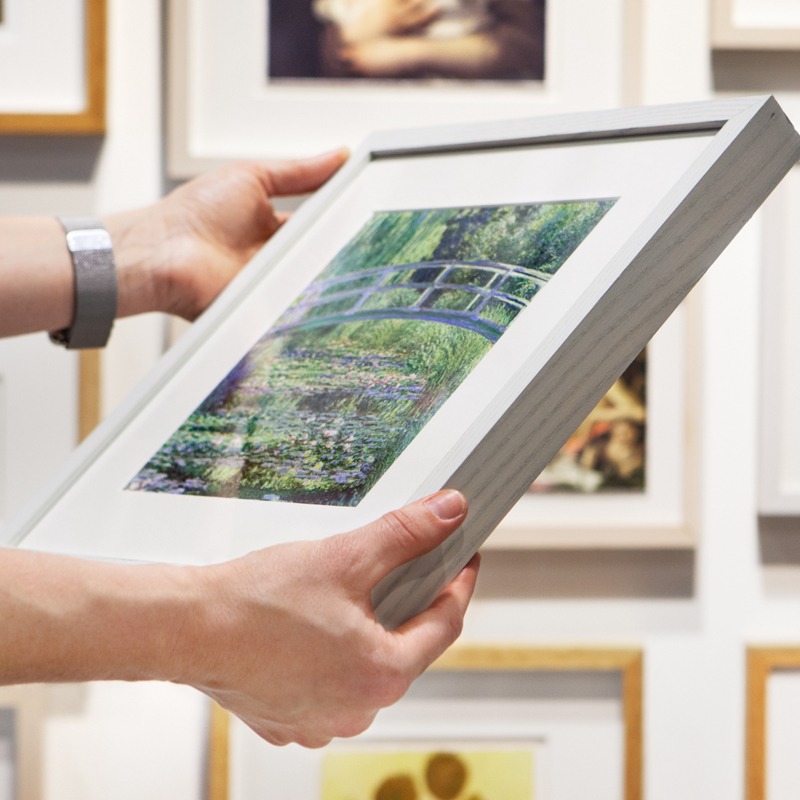Paul Cezanne, 'The Grounds of the Château Noir', about 1900-4
About the work
Overview
The Château Noir was a rambling house situated in extensive grounds near Aix-en-Provence in the south of France. Surrounded by wild vegetation, the run-down, isolated chateau offered Cezanne many subjects, and it became one of his favourite locations. He rented a small room in the house from 1897 to 1902, and continued to paint in the grounds until his death in 1906.
In his final years Cezanne was increasingly drawn to harsh landscapes untouched by human intervention. We are looking here at a group of trees growing along a remote rocky ridge on a hill north-east of the house. The diagonal slope of the hill is so steep that the rocks seem close to tumbling out of the frame. Dense woodland that writhes up from the rocks forms a screen that almost blocks out the sky, which we only glimpse towards the top of the picture as areas of pale blue. The picture’s generally sombre colours contribute to its somewhat oppressive, even claustrophobic atmosphere.
Key facts
Details
- Full title
- The Grounds of the Château Noir
- Artist
- Paul Cezanne
- Artist dates
- 1839 - 1906
- Date made
- about 1900-4
- Medium and support
- oil on canvas
- Dimensions
- 90.7 × 71.4 cm
- Acquisition credit
- Bought, 1963
- Inventory number
- NG6342
- Location
- Room 44
- Collection
- Main Collection
- Frame
- 17th-century French Frame
Provenance
Additional information
Text extracted from the ‘Provenance’ section of the catalogue entry in Martin Davies, with additions and some revisions by Cecil Gould, ‘National Gallery Catalogues: French School: Early 19th Century, Impressionists, Post-Impressionists, etc.’, London 1970; for further information, see the full catalogue entry.
Exhibition history
-
2009Long Loan to Tate (2009 - 2019) (Tate Exchange Loans)Tate Gallery (London)25 March 2009 - 24 March 2019
-
2009Endless Forms: Charles Darwin, Natural Science and the Visual ArtsThe Fitzwilliam Museum16 June 2009 - 4 October 2009
-
2012Cézanne and the Past: Tradition and CreativitySzépművészeti Múzeum25 October 2012 - 17 February 2013
-
2013DLA Piper Series: ConstellationsTate Liverpool19 July 2013 - 19 June 2016
-
2020Cézanne: The Rock and Quarry PaintingsPrinceton University Art Museum7 March 2020 - 15 October 2020
-
2022Fernand Léger and the rooftops of ParisKröller-Müller Museum19 November 2022 - 2 April 2023
Bibliography
-
1935J. Rewald and L. Marschutz, 'Cézanne au Château Noir', L'Amour de l'Art, 1935, pp. 15-21
-
1936L. Venturi, Cézanne: Son art, son oeuvre, Paris 1936
-
1962Galerie Charpentier, Chefs-d'œuvre de collections françaises, Paris 1962
-
1964G. Bazin (ed.), Französische Malerei des 19. Jahrhunderts von David bis Cézanne (exh. cat., Haus der Kunst München, 7 October 1964 - 6 January 1965), Munich 1964
-
1965The National Gallery, The National Gallery: June 1962 - December 1964, London 1965
-
1970Davies, Martin, and Cecil Gould, National Gallery Catalogues: French School: Early 19th Century, Impressionists, Post-Impressionists etc., London 1970
-
1978W. Rubin et al., Cézanne: The Late Work (exh. cat. Museum of Modern Art, 7 October 1977 - 3 January 1978; Galeries Nationales du Grand Palais, ; The Museum of Fine Arts, 26 January - 19 March 1978), New York 1978
-
1979J. House and M. Stevens, Post-Impressionism: Cross-Currents in European Painting (exh. cat. Royal Academy of Arts, 17 November 1979 - 16 March 1980; National Gallery of Art, Washington, 25 May - 1 September 1980), London 1979
-
1980A. Bowness, Post-Impressionism: Cross-Currents in European and American Painting, 1880-1906 (exh. cat. National Gallery of Art, Washington, 25 May - 1 September 1980), Washington 1980
-
1986J. Rewald, Cézanne: A Biography, New York 1986
-
1990R. Verdi, Cézanne and Poussin: The Classical Vision of Landscape (exh. cat. Scottish National Gallery, 9 August - 21 October 1990), Edinburgh 1990
-
1995P. Smith, Impressionism: Beneath the Surface, New York 1995
-
1996J. Rewald, W. Feilchenfeldt and J. Warman, The Paintings of Paul Cézanne: A Catalogue Raisonné, London 1996
-
2001
C. Baker and T. Henry, The National Gallery: Complete Illustrated Catalogue, London 2001
-
2006A. Dumas and N. Ireson, Cézanne in Britain, (exh. cat. The National Gallery, 4 October 2006 - 7 January 2007), London 2006
-
2008F.A. Baumann and P.E. Tøjners, Cézanne and Giacometti: Paths of Doubt, (exh. cat. Louisiana Museum of Modern Art, 20 February - 29 June 2008), Ostfildern-Ruit 2008
About this record
If you know more about this work or have spotted an error, please contact us. Please note that exhibition histories are listed from 2009 onwards. Bibliographies may not be complete; more comprehensive information is available in the National Gallery Library.














